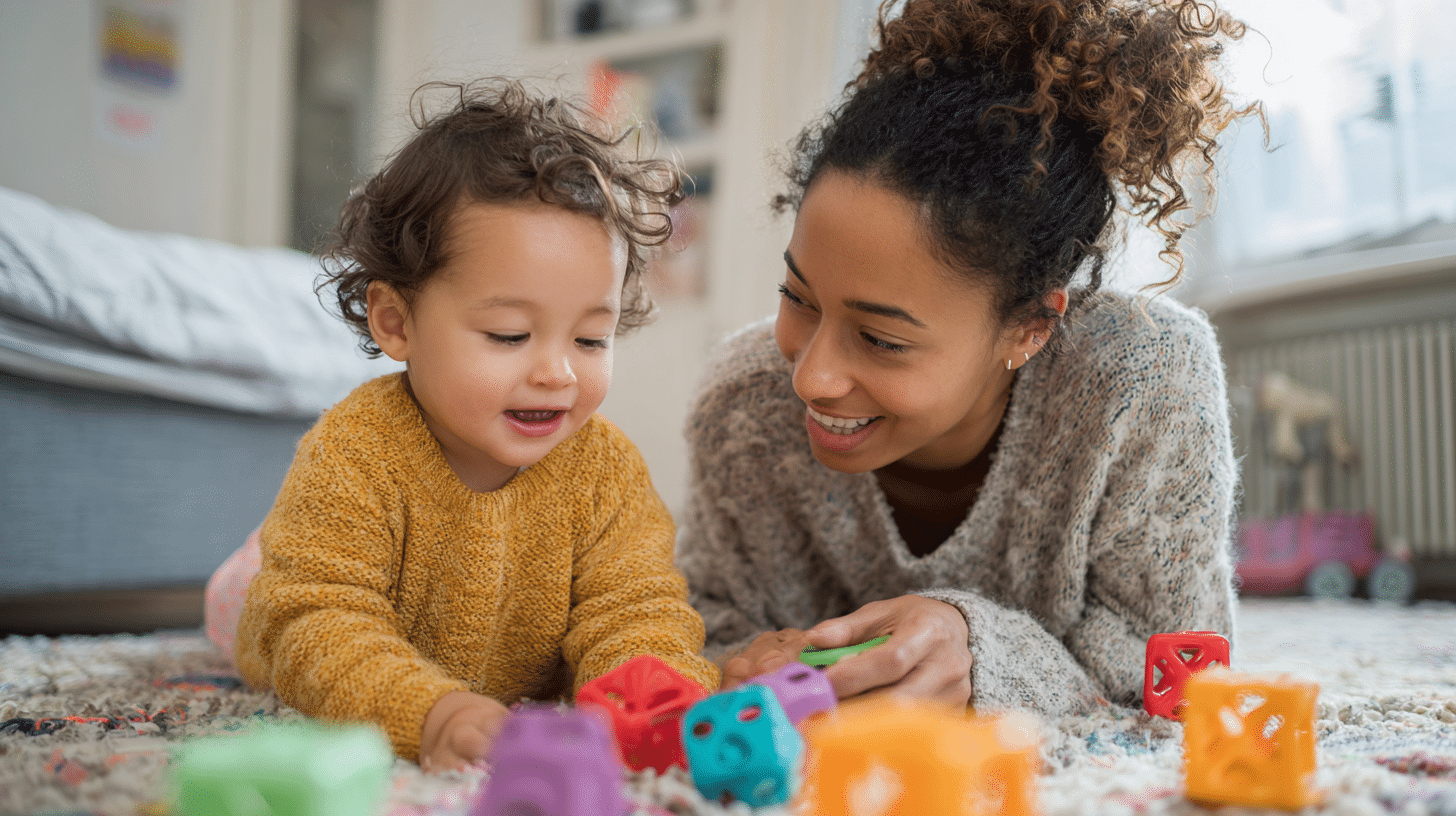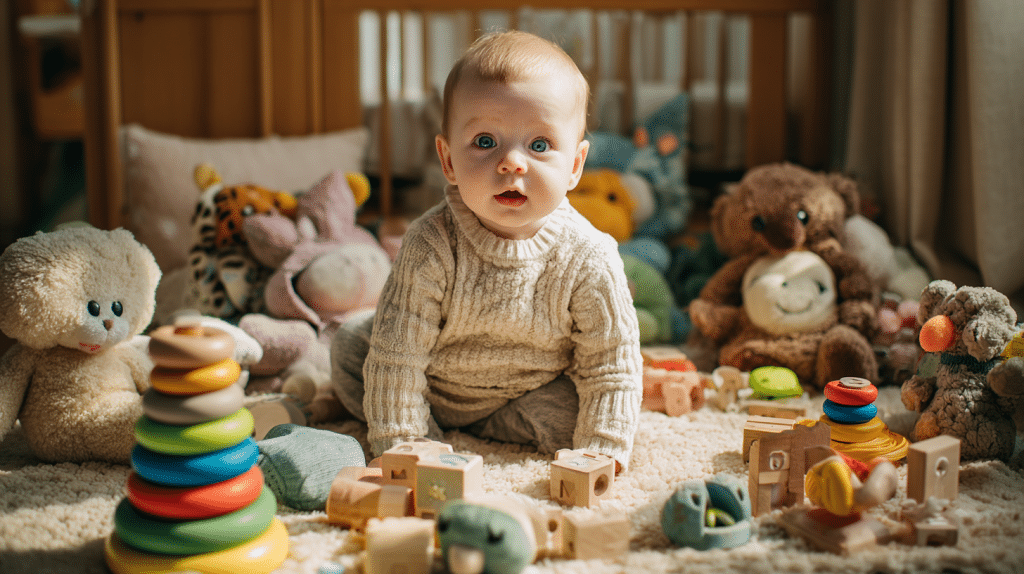Watching your toddler grow has been full of exciting changes, and I know you may feel the same. It helps so much to know what to expect so you can feel confident and prepared.
Around 15-month-old milestones, your little one may begin walking more steadily, trying new words, and showing affection in playful ways.
As they reach the 16-month milestone, you’ll notice stronger coordination, more pretend play, and growing independence.
In this blog, I’ll share milestones, practical tips, and signs to watch for to support your child’s development with ease.
Understanding a 15-month-old’s Development

At 15 months, your child is learning new skills almost every day, and it can feel like things change overnight. This stage is a mix of physical growth, social interaction, and early problem-solving.
Many toddlers are walking on their own, trying out new words, and showing affection through hugs or kisses. They are also curious about how things work, copying what you do, and enjoying simple games.
A quick checklist of typical milestones helps you see where your child is thriving and where they may need a little extra support.
It is not about keeping score but about noticing progress and giving your toddler the right opportunities to practice and learn.
15 Month Old Milestones for Kids
Your toddler is gaining new strength and coordination, opening the door to more active play and learning.
1. Physical Milestones
By 15 months, many toddlers are walking steadily, taking a few steps backward, and beginning to climb onto furniture or small steps with help.
Some may even start running in short bursts, though balance can still be wobbly. These skills open up new ways to understand their surroundings. Parents can support this growth by giving their child safe, open spaces to practice movement.
Supervised play outdoors or inside with soft flooring helps them gain confidence while staying protected from falls.
2. Motor Milestones
Fine motor skills also grow quickly at this age. Your toddler may enjoy stacking two or more blocks, scribbling with a crayon, or trying to turn pages in a book.
They are learning how to use their hands and eyes together, which builds coordination and control. Offering simple toys like stacking cups, large crayons, or shape sorters encourages practice.
Parents can also model actions like rolling a ball back and forth to strengthen these small but important skills.
3. Language & Cognitive Milestones
At 15 months, toddlers are rapidly learning how to express themselves and connect with the world. Their growing vocabulary and gestures show just how quickly their communication skills are developing.
- Vocabulary growth: By 15 months, many toddlers say a handful of words, often 5-15. These may include names for parents, favorite objects, or simple requests.
- Following instructions: They begin to understand simple directions like “come here” or “give me the ball.”
- Pointing and gestures: Pointing to objects or body parts shows they are learning to connect words with meaning.
- Imitation: Toddlers copy sounds, words, and actions they see from parents or siblings.
These milestones highlight the exciting progress your toddler is making in language and thinking. Each new word or action is a step toward stronger communication and understanding.
4. Social Milestones
At this age, many toddlers begin to show their feelings more openly. They may hug a parent or a stuffed toy, wave goodbye, or clap when excited.
Some children start enjoying simple pretend play, like stirring a spoon in a bowl or holding a phone to their ear. These little moments show they are learning how people connect with each other.
Parents can encourage this growth by responding warmly, smiling back, and modeling simple social gestures in everyday routines.
5. Emotional Milestones
By 15 months, toddlers often copy the emotions they see around them. They may laugh when others laugh or look worried if someone nearby is upset.
They are beginning to understand that their actions can make you smile or get your attention. Some toddlers may also show signs of independence, like insisting on holding a spoon.
Parents can support this stage by staying calm, offering comfort when needed, and creating a safe space where big feelings are accepted.
6. Self-Help & Independence
By 15 months, toddlers often want to do things on their own, even if it gets messy. Many can hold a spoon or cup with some success, and they may try to feed themselves finger foods.
They also show curiosity about routines, like wanting to help close a door or copy you while cleaning.
This stage is all about building independence and confidence, so giving them safe chances to practice daily tasks is an important part of their growth.
Red Flags & When to Seek Help
Most toddlers follow a similar path, but sometimes delays can signal the need for extra attention. Knowing what to watch for helps you act early and feel more prepared.
Red Flags to Watch For:
- Not saying any words by 15 months
- Showing no interest in walking
- Not responding to their name
- Rarely making eye contact or showing affection
These signs don’t always mean something is wrong, but they’re worth discussing with your pediatrician. Early support can give both you and your child the best start.
Activities to Support Development

At 15 months, play is one of the best ways to help your toddler learn new skills. Everyday activities build strength, coordination, language, and social awareness.
Simple games, pretend play, and hands-on tasks give them a safe way to practice what they are understanding about the world. These moments also deepen your bond, as your child learns best through time spent with you.
Choose activities that are fun, short, and easy to repeat, since toddlers thrive on familiar routines.
Examples:
- Peek-a-boo: A classic game that teaches object permanence and makes social interaction fun.
- Block stacking: Helps with hand-eye coordination, balance, and problem-solving as they figure out how to make a tower.
- Pretend cooking: Stirring a spoon in a bowl or “feeding” a doll supports imagination and early pretend play.
- Point and name: Read a picture book or look around the room, pointing to objects as you name them to build vocabulary.
- Ball rolling: Rolling a ball back and forth encourages turn-taking and improves both motor skills and social skills.
- Crayon scribbling: Holding large crayons and making marks strengthens fine motor control and prepares for later writing.
What’s Next After 15 Months
As your toddler moves past 15 months, their skills begin to grow more quickly and build on what they already know.
Many children start walking with more balance, climbing with confidence, and showing stronger coordination in play.
Vocabulary often increases, with some toddlers trying to combine two simple words. Socially, you may see more pretend play, gestures, and independence in daily routines.
These 16-month-old milestones give you a glimpse of the exciting progress to come as your child’s world keeps expanding.
Tips for Parents
Toddlers thrive when given chances to practice new skills on their own. A little patience and encouragement can go a long way in building their confidence
- Let your toddler try feeding themselves, even if it takes longer.
- Keep meals stress-free by expecting spills and managing the mess with bibs or mats.
- Offer small opportunities for independence, like handing you your shoes or helping tidy up.
These small steps may feel simple, but they give toddlers a sense of control and accomplishment. Over time, these everyday moments help them grow more capable and confident.
Conclusion
Watching your toddler grow through the 15-month stage is full of little wins and learning new things.
Each step, word, or playful gesture shows how much they are learning about themselves and the world around them. While milestones give a helpful guide, remember that every child develops in their own time.
I believe what matters most is offering love, patience, and safe chances to practice new skills each day. Trust your instincts, celebrate progress, and don’t hesitate to ask for support if something feels off.
Parenting at this stage can feel busy, but it’s also deeply rewarding.
Frequently Asked Questions
How much should a 15-month-old sleep in a day?
Most 15-month-olds need about 12 to 14 hours of sleep in 24 hours. This usually includes one long nap during the day and 10 to 12 hours at night. A consistent bedtime routine helps toddlers settle more easily and get the rest they need.
What kind of diet is best for a 15-month-old?
At this age, toddlers should eat a variety of solid foods from all food groups. Whole milk can replace formula if your pediatrician agrees, while breastmilk can continue if preferred.
How many teeth should a 15-month-old have?
There is a wide range of normal when it comes to teething. Some toddlers may have as few as four teeth, while others may already have a full set of eight to twelve. Teething patterns vary, so focus more on steady progress than an exact number.











